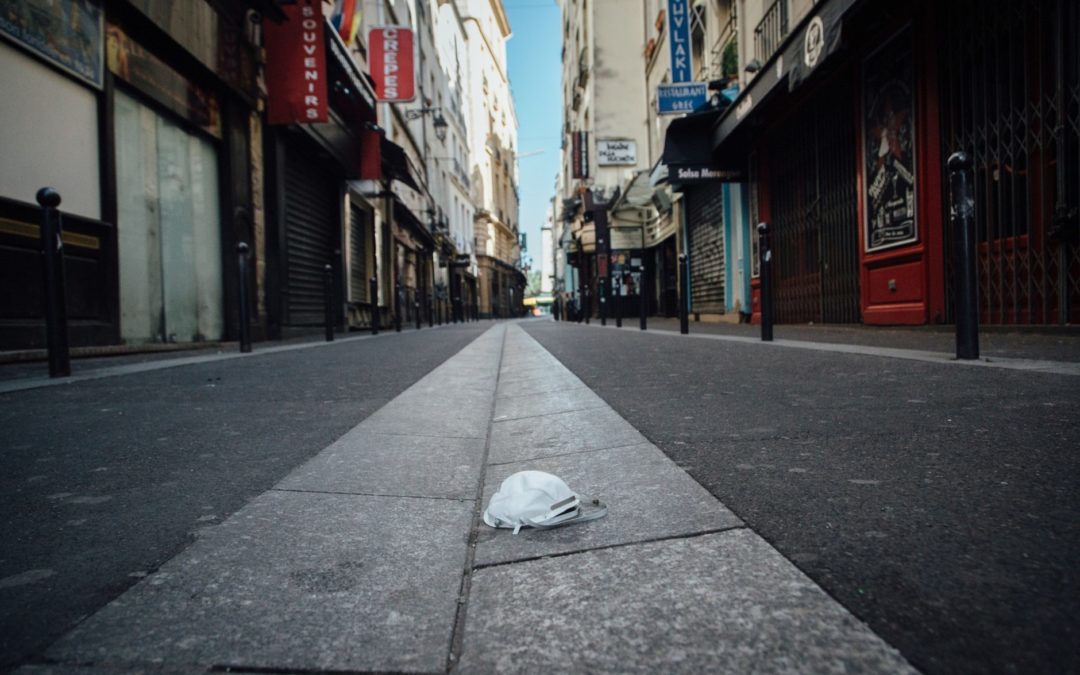↑ A deserted street in the Saint Michel district of Paris. Cyril Marcilhacy/Bloomberg
This article examines what intrinsic aspects of cities can legitimately be shown to be problematic or assets in epidemics and points to ways smart cities should address problematic areas for the future.
 by SAMUEL KLING – 20 April 2020
by SAMUEL KLING – 20 April 2020
Is the City Itself the Problem?
There’s a long history of blaming urban areas rather than economic factors for physical and moral ills. But density can be an asset for fighting coronavirus.
But the diagnosis of Covid-19 as a uniquely urban problem reflects historical tropes about the dangers of urban space more than current evidence. Statistical analyses do not show a consistent connection between big-city density and coronavirus impacts. Some of the world’s most heavily settled spaces — Hong Kong, Seoul, Singapore — have proved to be the most formidable at containing Covid-19. In the U.S., small towns in Georgia et Louisiana suffer along with New York City.
The belief that the urban environment was “pestilential to the morals, the health, and the liberties of man,” as Thomas Jefferson had famously written, reached a high point with the unprecedented urbanization of the 19th century. Between 1850 and 1900, New York grew more than sixfold to 3.4 million, Berlin quadrupled in size to 1.9 million, and Chicago — the “shock city” of the 19th century — grew nearly 60 times, to 1.7 million. In the United States, a rural society before the 20th century, the social changes were as profound as the physical ones. Observers noted the city’s physical disorder, crime, and disease, its extremes of poverty and wealth, and its startlingly diverse populations.
The civic reformers who sought to address these problems saw little difference between the city’s threats to residents’ physical health and its threats to their moral health. Both, they believed, sprouted from a common root: congested, squalid, and inhumane urban spaces. Jacob Riis, famous for his photos of grimy apartments, wrote that the tenements were not just “hot-beds” of “epidemics,” but also “touch the family life with deadly moral contagion” — which he conveyed to his middle-class readers in lurid detail. Daniel Burnham and Edward Bennett, the pioneer authors of the 1909 Plan of Chicago, agreed that excessive “density of population… results in disorder, vice, and disease, and thereby becomes the greatest threat to the city itself.” Another housing crusader, Lawrence Veiller, agreed, telling municipal officials in 1911, “Environment leaves its ineffaceable records on the souls, minds, and bodies of men.”
Crowded tenements and inhumane conditions did indeed have deleterious effects on residents. But moral environmentalists tended to blame urban spaces while neglecting the economic system that created these spaces. If changing the urban environment could solve urban social problems, then the economic system of industrialization could be left more or less intact. No wonder that a standard method for improving impoverished, overcrowded urban neighborhoods was simply to demolish them.
Parks, predicated on the idea that space was the problem, did not address the larger system that created inhumane urban spaces in the first place.
Park advocates embraced careful design because they viewed aesthetic reform as a tool for social reform. According to Olmsted, the movement’s leader, the reasons the “amount of disease and misery and of vice and crime has been much greater in towns” were environmental: lack of fresh air and the constant stimulation of bustling city life. Only “relief from” city life could return residents to “a temperate, good-natured, and healthy state of mind.” Olmsted viewed urban life as a threat to “the mind and the moral strength” of residents: In spaces like New York’s Central Park, Olmsted and his design partner Calvert Vaux shunned the geometric designs popular in European capitals in favor of naturalistic environments intended to calm the mind.
Never mind that park landscapes were themselves artificial: hills leveled and built up, ponds dug, and existing vegetation replaced with thousands of foreign and native plants. Above all, they were counterpoints to the 19th-century city. In reformers’ view, creating naturalistic spaces could improve public health alongside civic health, and cure physical ailments together with moral ones. They believed they could quell the threat of social disorder by providing a structured, common space for cities’ motley populations. Some contemporaries took their belief in parks’ healing powers to improbable lengths: As historian Paul Boyer writes, one park administrator claimed in a popular reform journal that with a bigger parks budget, he could decrease prostitution in his city by 98 percent.
What lessons will today’s city leaders take away from the pandemic? As in the past, the answer partly depends on how they diagnose the problem. If they follow the precedent of moral environmentalism, they will fault the city itself. But doing so distorts the reality of the pandemic and obscures the systemic policy failures that have made certain places and populations — particularly urban African Americans — far more vulnerable.
The dense urban environment can also be an asset in fighting disasters like Covid-19. Density means cities can more easily concentrate resources and social services where needed. Residents, in theory, have quicker access to hospitals and health care. And when nurtured by “social infrastructure” — community centers, libraries, and yes, public parks — cities can generate lifesaving networks of social ties which combat isolation and mitigate the effects of disasters.
Cities are vulnerable amid the pandemic, but they are not the problem. Recognizing that fact is the first step to addressing coronavirus on its own terms, as it appears not just in cities, but also in suburb and countryside — and to building a more resilient, humane urban life afterward.
View original article at www.citylab.com





Commentaires récents